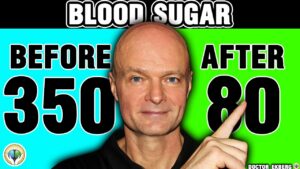In this video, the speaker explains the difference between fluffy and bullet-like LDL cholesterol and how they affect the body. Fluffy LDL cholesterol is considered healthy and is increased by eating saturated fats, while bullet-like LDL cholesterol, known as the „bad cholesterol,“ is increased by eating carbs. Taking a Statin medication lowers the LDL cholesterol floating in the lipoproteins in circulation, but not the ones stuck in the arterial wall that can cause a heart attack. The speaker emphasizes the importance of lowering inflammation and insulin resistance to prevent cardiovascular issues. It is advised to consult a doctor before making any changes to Statin medication.

Our Summaries are written by our own AI Infrastructure, to save you time on your Health Journey!
Key Insights:
- When getting your cholesterol checked, you are actually checking lipoproteins, which carry fatty substances in your blood.
- There are different types of lipoproteins, including chylomicrons, VLDL (very low-density lipoprotein), and LDL (low-density lipoprotein).
- LDL is often referred to as „bad cholesterol,“ but there are actually two types: fluffy LDL and small, dense LDL.
- Fluffy LDL is considered normal and is part of a healthy metabolism.
- Small, dense LDL is the more harmful type and is associated with insulin resistance and high insulin levels.
- High insulin prevents the recycling of LDL cholesterol back into the liver, leading to its accumulation in the arterial walls.
- When small, dense LDL particles accumulate in arterial walls, they can become oxidized and trigger an immune response, potentially leading to heart attacks.
- Taking a Statin medication can lower LDL cholesterol circulating in the bloodstream, but it doesn’t specifically target the LDL particles stuck in the arterial walls.
- Preventing heart attacks requires addressing insulin resistance and lowering inflammation, not just focusing on lowering LDL cholesterol levels.
- Studies have shown varying effectiveness of Statins in preventing heart attacks, with a need to treat a significant number of patients to prevent one event.
- Talk to your doctor before considering any changes to your medication or treatment plan based on information from a video.
- Fixing insulin resistance is a complex process that requires understanding and addressing the underlying metabolic rules.
Transcript
This is your bad cholesterol, and this is your bad cholesterol. One will kill you, the other one is part of a healthy metabolism. If you’re taking a Statin, which one does it lower? Let’s take on this topic of cholesterol.
First of all, when you go to the doctor to get your cholesterol checked, you’re actually not checking your cholesterol, you’re checking lipoproteins. These are the carrying units that carry around the fatty substances. Your blood is water-soluble, and if fat floated around in it, it would cause a clot. So, we have to measure these lipoproteins.
This one is a chylomicron. It comes out of the liver and is the biggest and fluffiest one. But notice what’s here, these are what we are talking about on your lab reports. This is a VLDL, much smaller than a chylomicron. And this one is smaller yet, it’s gotten rid of more of its fuel. It’s called an ideal. And finally, here’s the bad boy called an LDL, a bad cholesterol, a low-density lipoprotein. But we have two of them. One that’s fluffy and one that’s a bullet. Notice that both of these have lots of cholesterol components in them, but one of them is much smaller and more deadly.
So let me further explain the difference of how you get from a fluffy LDL to a bullet LDL. So let’s talk about this cycle and begin with a healthy patient. Here is a perfect, pristine liver, and it has packaged the fat into chylomicrons. These last a hot minute in our system and are quickly converted into IDLs by getting rid of a bunch of triglycerides. These are nutrients for ourselves and our body.
These VLDLs offload the triglycerides, some of that fatty nutrients to our cells, and they get smaller. That smaller version is an IDL. Notice how the cholesterol is more concentrated every step we go. The next packaging is the LDL, better known as the bad cholesterol. These lipoproteins are the smallest, and they have the least amount of triglycerides and the most amount of cholesterol left in them, and they get recycled back into your liver. They’re gonna get repackaged and put back into the chylomicrons. This is what healthy looks like. Your liver packages up the nutrients, the good stuff, the fat, and it delivers it throughout the body, and then it recycles to do it all over again. That’s normal.
This is not normal. Not normal starts with high insulin. Notice our liver does not look so healthy anymore, and those chylomicrons are going to do what they do. They’re going to get rid of a bunch of triglycerides and transition into the IDLs. Those VLDLs are going to try to get rid of that commodity. They’ve got triglycerides, but the cells are kind of full. They’ve got the energy they need, so it takes them a little longer to get rid of it. But now the IDL does come about, and as they get rid of those triglycerides and transition into this smaller version of the lipoprotein, the IDL, it is a final resting point for the LDL, that bad cholesterol. And now we have a problem. That insulin is preventing the recycling of going back into the liver. And if you look, that liver is pretty full of a job it’s trying to do already.
This is a close-up of your blood vessel and the little lining of the blood vessel. And this is healthy cells, which are pretty boring. The LDL cholesterol comes in, and it goes into the liver, not much to see here. But when its lunch shows up, it starts to deteriorate the lining of the inside of your blood vessels, and some gnarly things start to happen. Let me show you a liver that lives with normal insulin and elevated insulin.
During a state of elevated insulin, your liver fills up with a bunch of stored glucose called glycogen. Once those storage bins are all filled, a layer of fat storage begins. These are triglycerides, that storage bin then quickly fills up as well, and the liver starts to change. It gets harder, it gets filled jam-packed filled with fat, and that hardening of the liver is cirrhosis. Today, most people with cirrhosis of the liver don’t have liver cancer or even alcoholism. They have cirrhosis of the liver from too much fat in their liver, that’s from high insulin.
So let’s dive back into that blood vessel and see what happens in a state of high insulin. First, we begin without the protective layer that’s naturally found on the skin layer inside your blood vessels. As the LDL cholesterol comes in and tries to get into the liver but many times can’t, these very small, dense bullet-like LDLs slip between the cells and are now in the arterial wall. This is not good. They’re looking for a parking spot. They ran out of parking spots in the liver, and they happen to fit in this secret compartment in the lining of your arteries.
Your body is going to try to protect itself. First, it changes the LDL particle, it oxidizes it. This signals to the white blood cell system to come in and attack. It doesn’t belong there. The body is trying to shoot clean up, get it out of there. And as it does this to one particle, no big deal. But as LDL particles in the small, dense, bullet-like version dip into this hiding spot, it recruits more and more and more of your immune system’s attention. And eventually, you’ve got a mess. Here is where your small, dense, bullet-like LDLs are ending up, it’s an oxidized LDL. If you’ve worried about having that heart attack as you eat a bunch of fatty foods, wondering does it end up in your artery, this is not the process. This fatty, gooey substance came from the inability to recycle that good, fluffy LDL cholesterol in the liver. And if it pops, if this leaks into your blood system, it does cause a heart attack.
So if you’re taking a Statin in hopes that you lower your LDL cholesterol, your bad cholesterol, you’re going to lower the LDL cholesterol floating around in the lipoproteins in circulation, not the ones stuck in the arterial wall that will cause a heart attack.
So here we have your low-density lipoproteins filled with cholesterol. This one is fluffy. This one is your bullet. This one does not cause a heart attack. This one does. This one is increased by eating saturated fats. This one is increased by eating carbs. This one is lowered by a Statin, and this one is not.
If you’re a physician seeing patients in the last 30 years trying to prevent a heart attack, you’ve written for statins hoping to prevent that heart attack. But you might be interested to know that in some studies, you would have to treat 50 patients for two years taking a Statin every day to prevent one heart attack. In other studies, it was over 200 patients were needed to treat in order to prevent one heart attack. If you’re taking a Statin and you’re trying to prevent a heart attack, do not stop your Statin by watching a YouTube video. Talk to your doctor.
If you’re trying to prevent that gooey stuff living in your arterial wall from exiting and causing a heart attack, you need to lower the inflammation. In other words, you need to decrease the insulin. And if you’ve got enough of that goo around your system, it means your insulin probably isn’t listening to you. It’s resistant. Fixing insulin resistance is not child’s play. You need to know the rules. Check out this video. I will teach you them.





